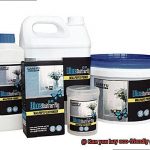Epoxies are the go-to for home improvement projects, thanks to their incredible strength, versatility, and longevity. But what happens when your epoxy project goes awry? Can you dissolve cured epoxy and start over? As a DIY enthusiast, this is a question that may have crossed your mind.
While epoxy resins are designed to be tough and durable, they’re not invincible. The good news is that in some cases, it’s possible to dissolve cured epoxy. However, not all epoxies are created equal; some are more resistant to solvents than others. Knowing which type of epoxy you’re dealing with and what solvents to use can make all the difference in successfully dissolving cured epoxy.
In this blog post, we’ll delve into the complexities of dissolving cured epoxy. We’ll cover everything from what solvents work best to which types of epoxies can be dissolved. With our expert insights, you’ll learn the best practices for removing old cured epoxy from any surface, giving you a fresh start for your next project.
So, whether you need to remove an old epoxy finish from your countertops or fix an epoxy mistake, stay tuned to learn all about dissolving cured epoxy.
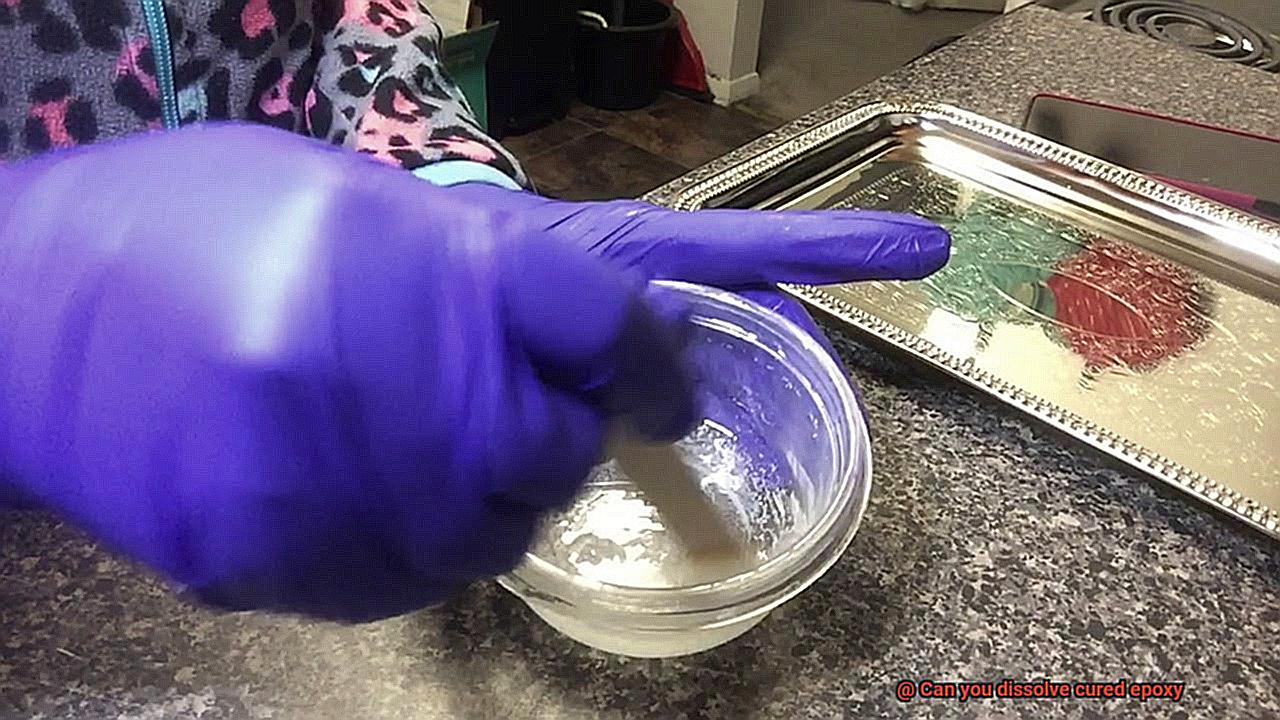
What is Epoxy?
Contents
- 1 What is Epoxy?
- 2 Can You Dissolve Cured Epoxy?
- 3 Methylene Chloride: The Most Effective Solvent for Dissolving Cured Epoxy
- 4 Acetone and Vinegar: Other Solvents that Can Dissolve Cured Epoxy
- 5 How to Use Solvents to Dissolve Cured Epoxy
- 6 Safety Precautions When Using Solvents to Dissolve Cured Epoxy
- 7 Factors That Affect the Effectiveness of Solvents on Cured Epoxy
- 8 Alternative Methods for Removing Cured Epoxy
- 9 Conclusion
Epoxy is a powerful adhesive that has taken the world by storm due to its exceptional bonding strength, durability, and resistance to chemicals and moisture. It consists of two components – resin and hardener – that are combined to create a chemical reaction resulting in a robust and long-lasting bond.
This versatile adhesive has found its way into several industries, including construction, automotive, marine, and even art. In construction, it is used for flooring, concrete repair, and waterproofing. In the automotive industry, it is used for bonding body panels, while in marine applications, it is used for boat building and repair.
One of the key properties of epoxy is its ability to cure or harden over time. Once fully cured, the epoxy creates a solid material that is difficult to break or dissolve. This makes it an ideal adhesive for applications where strength and durability are paramount.
Epoxy can be purchased in different forms such as liquid or paste, depending on the application. It can also come in various colors and finishes to suit different needs. This versatility allows epoxy to be used in both industrial and creative settings.
While epoxy is difficult to dissolve once it has fully cured, there are certain solvents that can be used to remove it if necessary. Methylene chloride is one of the most effective solvents for dissolving cured epoxy. Acetone and vinegar can also be used but may require more time and effort. However, it’s crucial to handle these solvents with care as they can pose a health hazard.
Can You Dissolve Cured Epoxy?
Epoxy is a revolutionary adhesive that has revolutionized the world of construction, automotive manufacturing, and aerospace. Its unparalleled strength, durability, and resistance to chemicals and moisture have made it a popular choice in various industries. However, what happens when you need to remove cured epoxy from a surface? Can you dissolve cured epoxy? In this article, we will explore the process of dissolving cured epoxy.
To answer the question, the short answer is yes, you can dissolve cured epoxy. However, it’s not as simple as you might think. Epoxy is designed to be resistant to most chemicals, including solvents and acids. This means that dissolving cured epoxy requires more aggressive solvents such as methylene chloride or dimethylformamide (DMF). These solvents are highly toxic and should only be used by professionals in well-ventilated areas with proper protective gear.
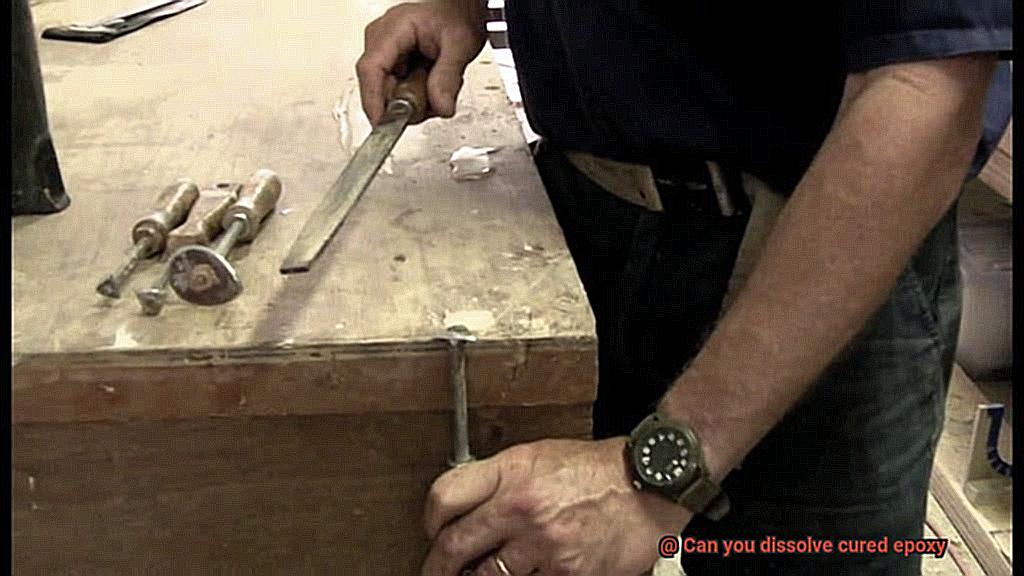
It is important to note that using aggressive solvents is not a one-size-fits-all solution. Even with the use of these solvents, it may not be possible to completely dissolve cured epoxy. The solvent may only soften the epoxy, making it easier to remove mechanically. Additionally, these solvents can damage certain materials like plastics or rubbers.
To dissolve cured epoxy, here are some steps you can follow:
- Prepare your work area: It’s essential to work in a well-ventilated area with proper protective gear such as gloves and goggles.
- Choose your solvent: Methylene chloride or DMF are commonly used solvents for dissolving cured epoxy.
- Apply the solvent: Use a brush or cloth to apply the solvent to the affected area. Ensure that you apply enough solvent to cover the entire area.
- Wait: Allow the solvent to sit on the surface for at least 30 minutes. This gives it time to work its magic.
- Test: After 30 minutes, test the area to see if the epoxy has softened. You can do this by gently scraping the surface with a plastic scraper. If the epoxy has softened, move on to the next step.
- Remove the epoxy: Use a plastic scraper or sandpaper to remove the softened epoxy. Repeat steps 3-5 as necessary until all the epoxy is removed.
Methylene Chloride: The Most Effective Solvent for Dissolving Cured Epoxy
Removing cured epoxy can be a daunting task, but fear no more. The most effective solution for dissolving cured epoxy is methylene chloride, also known as dichloromethane. This colorless liquid with a slightly sweet smell is commonly used in paint strippers, degreasers, and solvents.
Methylene chloride has a low boiling point and evaporates quickly, which means it can penetrate the surface of the epoxy and dissolve it from within. It’s an excellent solvent for dissolving cured epoxy without damaging the underlying material. Additionally, it’s readily available and affordable, making it a popular choice among those in need of an epoxy dissolver.
However, it’s important to take the necessary safety precautions before using methylene chloride to dissolve cured epoxy. This solvent is highly toxic and can be harmful if not used properly. Protective clothing, gloves, and a respirator should be worn when handling methylene chloride. It’s also crucial to use it in a well-ventilated area to avoid inhaling vapors.
Using methylene chloride to dissolve cured epoxy is straightforward. Simply apply the solvent directly to the epoxy surface and allow it to soak for several minutes. The length of time required will depend on the thickness of the coating and the type of epoxy used. Once the epoxy has dissolved, it can be scraped away or wiped away with a cloth.
It’s important to note that while methylene chloride is highly effective at dissolving cured epoxy, it may not be suitable for all types of epoxies. Some epoxies may be resistant to this solvent or may require longer soaking times. Additionally, methylene chloride may not be effective at dissolving large amounts of cured epoxy.
Acetone and Vinegar: Other Solvents that Can Dissolve Cured Epoxy
Don’t let cured epoxy get you down. If you’re struggling to remove it from surfaces or objects, look no further than your own household for two common solvents that can dissolve it: acetone and vinegar.
Acetone is a powerful solvent that is commonly used in industrial settings for cleaning and degreasing. It’s also a popular choice for removing cured epoxy because of its ability to break down the resin quickly and effectively. However, it’s important to note that acetone can be harsh on certain surfaces, such as plastics or painted surfaces, and may cause damage or discoloration if not used properly.
On the other hand, vinegar is a gentler solvent that can also dissolve cured epoxy but may take longer to do so. It works by breaking down the molecular structure of the resin over time, eventually causing it to loosen and separate from the surface. While vinegar is less harsh than acetone, it may not be as effective in removing large amounts of cured epoxy or epoxy that has been allowed to fully cure for an extended period of time.
Before using any solvent on a surface, it’s important to test a small, inconspicuous area first to ensure that it does not cause damage or discoloration. Protective clothing, gloves, and a respirator should also be worn when working with solvents.
How to Use Solvents to Dissolve Cured Epoxy
When you need to remove cured epoxy from a surface, solvents can be your best bet. However, it’s important to choose the right solvent for your specific needs and understand how to handle them safely.
There are several solvents that can dissolve cured epoxy, including acetone, MEK, and DMF. Acetone is a powerful solvent that can quickly break down the epoxy, while MEK and DMF work by breaking down the chemical bonds within the cured epoxy. However, the effectiveness of a solvent depends on the type of epoxy and the exposure time required to dissolve it.
To use a solvent, apply a small amount of it to the cured epoxy and let it sit for several minutes. Then, use a scraper or brush to gently remove the dissolved epoxy from the surface. It’s important to wear protective gear and use solvents in a well-ventilated area to prevent any harm to yourself or others.
However, solvents can be harsh and potentially dangerous if not handled properly. Always follow the manufacturer’s instructions for the solvent being used and dispose of any leftover solvent according to local regulations.
Keep in mind that not all types of cured epoxy can be dissolved by solvents. In some cases, mechanical removal may be necessary. Additionally, using solvents may damage or discolor the surface underneath, so it’s important to test the solvent on a small, inconspicuous area before applying it to a larger surface.
Safety Precautions When Using Solvents to Dissolve Cured Epoxy
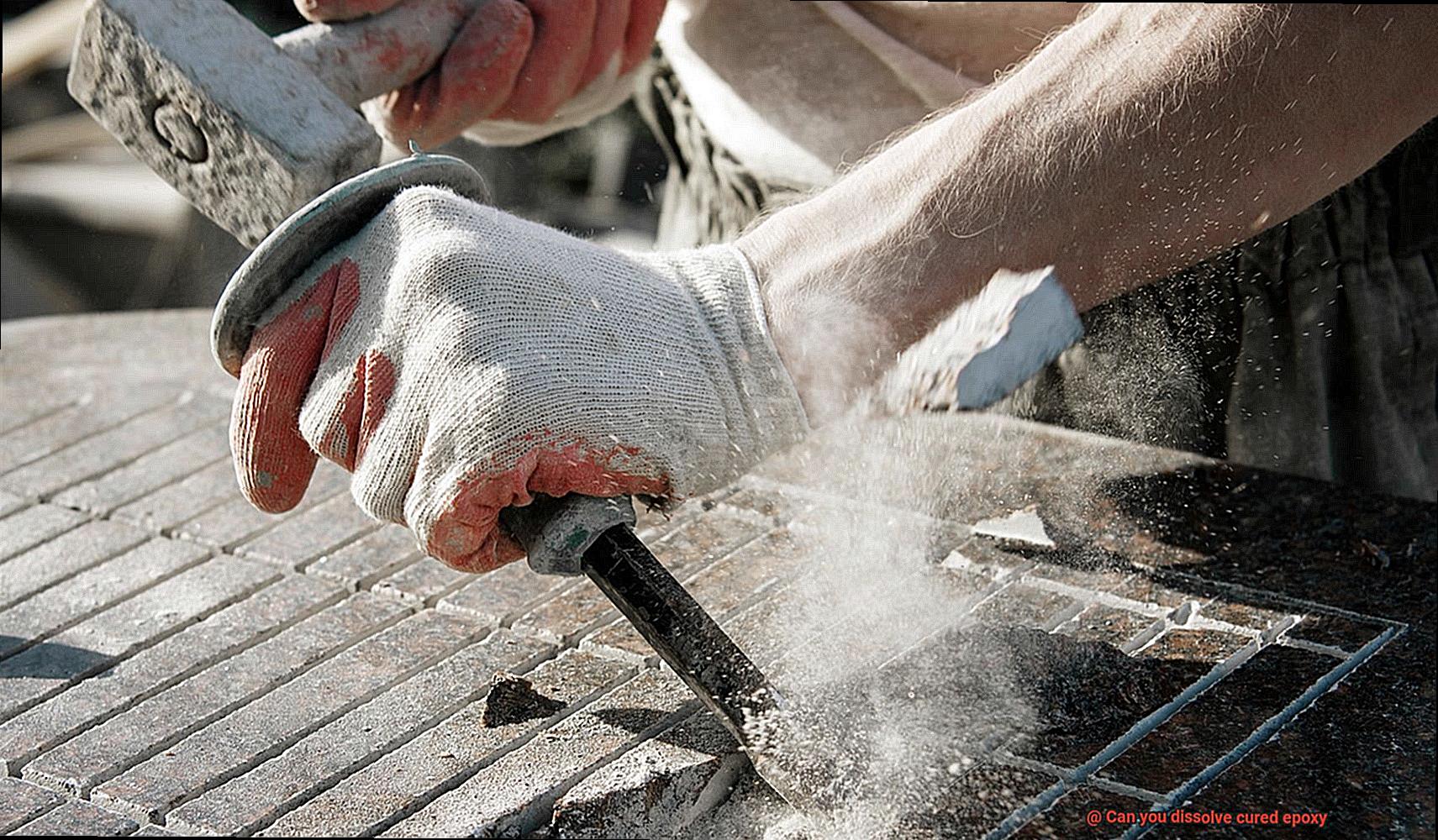
While solvents can be highly effective, it’s essential to take the necessary safety precautions to protect yourself from potential health hazards. As an expert on this topic, I’ve compiled a comprehensive list of safety measures that you should follow to ensure a safe and successful project.
First and foremost, make sure to work in a well-ventilated area. This means opening windows and doors or using a fan to create a constant flow of fresh air. Solvents release harmful fumes that can cause respiratory problems, headaches, nausea, and other health issues if inhaled for an extended period.
Next, it’s crucial to wear personal protective equipment (PPE) when working with solvents. This includes gloves, safety glasses or goggles, and a respirator mask. Gloves will protect your hands from direct contact with the solvent, while safety glasses or goggles will shield your eyes from any splashes or sprays of the solvent. The respirator mask will filter out any harmful fumes that may be present in the air.
Before using any solvent, read the label carefully and follow all instructions. This includes any warnings or precautions that may be listed on the label. Solvents can be hazardous if not handled correctly, so it’s important to store them properly in a cool, dry place and away from any sources of heat or flames.

In case of accidental ingestion or contact with your skin or eyes, seek medical attention immediately. Remember that solvents can be toxic and cause severe health problems if not handled correctly.
To summarize, prioritize safety when using solvents to dissolve cured epoxy. Here’s a quick checklist of safety precautions to keep in mind:
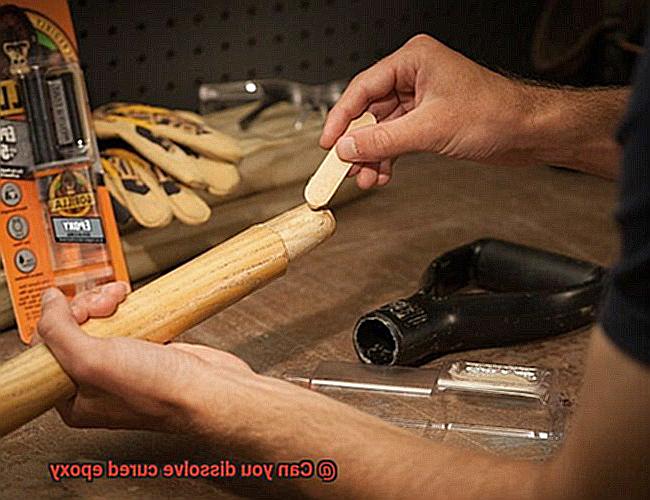
- Work in a well-ventilated area
- Wear PPE (gloves, safety glasses/goggles, respirator mask)
- Read the label carefully and follow all instructions
- Store solvents properly in a cool, dry place away from heat or flames
- Seek medical attention in case of accidental ingestion or contact with skin/eyes
Factors That Affect the Effectiveness of Solvents on Cured Epoxy
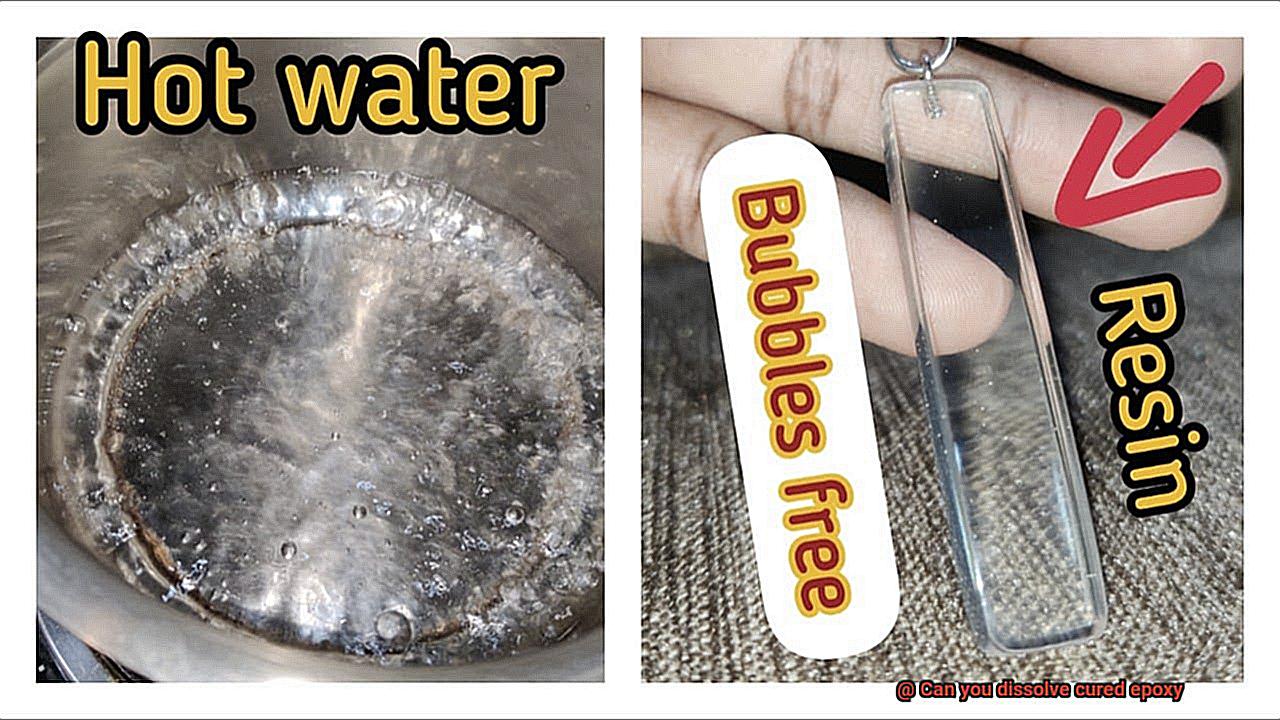
Well, before you dive in, it’s important to know that the effectiveness of solvents on cured epoxy can vary depending on several factors. As an expert in this field, let me elaborate on the key factors that affect the effectiveness of solvents on cured epoxy.
Firstly, the type of epoxy used is an essential factor to consider. Different types of epoxy have unique chemical compositions, and some are more resistant to solvents than others. Therefore, it’s crucial to select a solvent that is appropriate for the type of epoxy being used.
The second factor is the curing process of the epoxy. Epoxy can be cured chemically or using heat, and the curing process can significantly impact the solubility of cured epoxy. Heat-cured epoxy is generally more resistant to solvents than chemically-cured ones.
Thirdly, the type of solvent used can also affect its effectiveness. Solvents have different chemical properties, and some are polar while others are nonpolar. These properties can impact their ability to dissolve certain types of epoxy.
Lastly, the temperature and pressure at which the solvent is used can also impact its effectiveness. Higher temperatures and pressures can increase the effectiveness of solvents on cured epoxy, but they can also damage the underlying substrate if not used correctly.
It is vital to consider all these factors when attempting to dissolve cured epoxy using solvents. Always choose a solvent that is appropriate for the type of epoxy and take proper safety measures like wearing protective clothing and working in a well-ventilated area.
Alternative Methods for Removing Cured Epoxy
Removing cured epoxy can be a daunting task, but fear not. There are several alternative methods to choose from. Let’s explore your options and find the perfect solution for your needs.
First on the list is the heat method. By using a heat gun or hair dryer, the epoxy is softened, making it easier to scrape away. However, this method can be hazardous if safety precautions aren’t followed. Be sure to take all necessary measures before heating up the epoxy.
Another alternative is using solvents such as acetone, alcohol, or vinegar. These solvents break down the chemical bonds in the epoxy, making it easier to remove. But remember, not all solvents work for every type of epoxy, so it’s crucial to choose the right solvent to avoid damaging the underlying surface.
If you prefer a hands-on approach, mechanical methods might suit you better. Using sandpaper or a grinding wheel can physically remove the epoxy from the surface. However, be aware that this process can be time-consuming and may cause damage to the surface beneath the epoxy.
Finally, there are specialty products available that contain strong chemicals designed specifically for removing cured epoxy. While these products are effective, it’s essential to follow instructions carefully and use them cautiously.
v6LuNGv4IKo” >
Conclusion
In conclusion, epoxy is a formidable adhesive that can withstand the test of time. However, there may come a time when you need to remove cured epoxy from a surface or object. Fear not, as it is possible to dissolve cured epoxy with the right solvent and approach.
It’s important to note that not all epoxies are created equal, and some are more resistant to solvents than others. Therefore, before attempting to dissolve cured epoxy, it’s essential to identify the type of epoxy you’re dealing with and which solvents work best.
Methylene chloride reigns supreme as the most effective solvent for dissolving cured epoxy, followed by acetone and vinegar. But keep in mind that these solvents can pose health hazards if not handled properly. Always work in a well-ventilated area with protective gear such as gloves and goggles.
If solvents aren’t your cup of tea, there are alternative methods available such as using heat or mechanical removal. Whatever method you choose, prioritize safety measures and test a small inconspicuous area first before applying any solvent or removing the cured epoxy.
In summary, learning how to dissolve cured epoxy is an invaluable skill for any DIY enthusiast looking to fix an epoxy mistake or start fresh on a project. With the right knowledge and precautions in place, removing old cured epoxy from any surface can be done safely and effectively.





